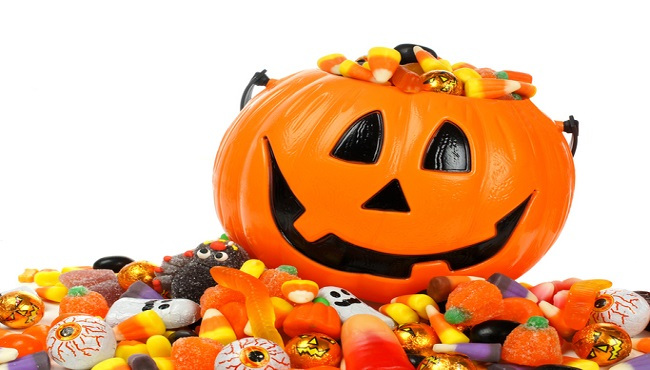The (Least) Wonderful time of the Year: What’s the matter with Halloween
Courtesy of Getty Images/iStockphoto
Jack-o-Lantern overflowing with Halloween candy
November 9, 2017
Halloween is the bright, pleasant time of the year that we celebrate sunshine, flowers, and the beauty of life. Right?
Wrong. Halloween is actually when we cover our houses with death-related decorations, dress up in often unpleasant costumes, watch horror movies, go to haunted houses, send little kids out into the streets at night, and eat an insane amount of candy.
It’s not the most pleasant of holidays, and its origins are little different.
Halloween traces back to the ancient Celtic festival of Samhain, a day associated with death and darkness in which the Celts believed the spirits of the dead were free to roam. Here, Druids would dress up in animal costumes, conduct fire ceremonies, and try to tell each other’s futures. This wouldn’t be my first choice for a tradition to base a national holiday off of.
The unpleasantness continues. When the Celts converted to Catholicism in the 5th Century A.D., the Church did not succeed in doing away with this tradition, but instead replaced it with All Saints Day on November 1st–also known as All Hallows Day, preceded by All Hallows Eve (later shortened to Halloween)–which later became a day to pray for the souls of the dead. Unsurprisingly, it also came to be largely mixed with the traditions of Samhain, masking its dark beliefs and practices in the dignified guise of holiness belonging to the Church–the perfect breeding-ground for hypocrisy and jumbled superstitious beliefs.
A good few centuries later, a tradition called “souling” became common in England, involving beggars going from house to house and collecting currant-biscuits called “soul cakes” in return for promising to pray for the dead relatives of the family. This was a fairly harmless, even helpful tradition–beggars were fed and the rich got their dead prayed for. But even this turned sour; before long, revelers began to emulate this tradition by donning masks and demanding food from their neighbors, mocking those who failed to comply. It became an all-out, rather Carnival-like night, where carousers disguised themselves and took to the streets, playing pranks and causing mischief. A pleasant story behind trick-or-treating, isn’t it?
The holiday soon moved to America with the flocks of Irish immigrants flooding in during the 1840s. Here, it caught on like wildfire. Anyway, what kind of person in their right mind wouldn’t want the perfect excuse to uproot fences and knock outhouses over?
Compared to what it used to be, there is fairly little vandalism involved in today’s Halloween, other than your occasional TP-ing of houses or trees. Despite this, however, new problems have arisen.
First, we spend an insane amount of money on it. The National Retail Federation estimated that the amount of money to be spent on Halloween this year would be $9.1 billion, 8.3% more than just last year’s celebration. Individual consumers are estimated to have paid an average of $86.13 just for Halloween-related expenses, over $25 of which will be spent on candy–$2.7 billion nationally. That’s a lot of money.
Secondly, kids eat tons of candy on Halloween. According to a study by Children’s Healthcare of Atlanta, trick-or-treaters can consume up to three cups of sugar on Halloween–24 times the maximum amount of sugar recommended for children daily by the American Heart Association. Sure, most parents do try to stem their child’s sugar consumption at least to some extent, and a movement is being made towards a “Healthy Halloween.” But those with a sweet tooth just cannot pass up such a great opportunity to guzzle some sugar, with or without the consent of their parents.
Third, Halloween can be dangerous for trick-or-treaters. A study by Safe Kids Worldwide found that twice as many child pedestrians die on Halloween than other days of the year. Sending all the little kids out at once into the streets in the evening or night is just asking for accidents to occur. Halloween also provides a great excuse for adults to throw parties–often involving liberal consumption of alcohol–resulting in a large number of drunk drivers late that night.
Halloween generally has bad taste. Granted, it is a fun opportunity for kids to dress up, and also is probably the one time of the year that they visit more than just a few of their neighbors. But when the whole holiday celebrates death, horror, superstition, witchcraft, ghosts, and the living dead in general, it never is going to be an altogether pleasant one. We fill our heads with repulsive trash from horror movies and pay to be scared by going to haunted houses, getting nothing more than pumping adrenaline and the relief of being finished in return. We decorate our lawns and houses with death-related symbols, and trick-or-treaters often dress up as unpleasant creatures in the ever-escalating contest to look the scariest or most morbid. The whole holiday is a nasty time where we let loose the foul side of our imaginations. Unlike the candy we stuff ourselves with there, Halloween has very bad taste.

